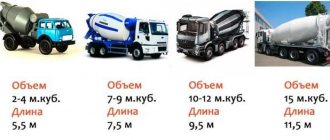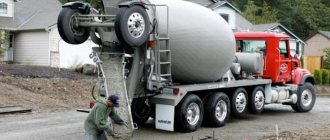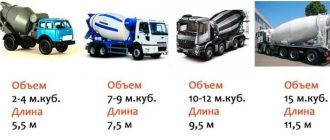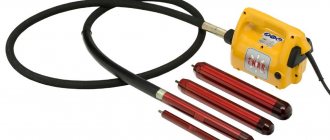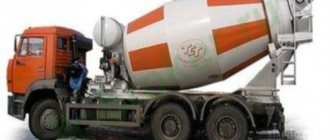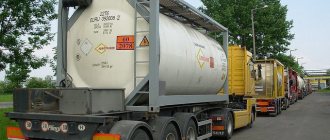When calculating how many cubes of concrete are in a KamAZ mixer, you can find out what the capacity of a concrete mixer truck (concrete mixer truck, concrete truck) is and how many trucks will be needed to transport the volume of concrete required for construction. The need for transportation is determined by the following factors:
- the concrete solution prepared manually at the construction site has worse quality and technical parameters than the one made in a KamAZ mixer at a specialized plant;
- thanks to the concrete mixer, the solution remains homogeneous, does not separate, does not splash, and does not leak along the way from the plant to the construction site.
The main advantages of delivering concrete by mixer
Purchasing and transporting concrete mixture in this way has its advantages:
Convenient delivery and unloading of concrete
- the ability to transport material over long distances without loss of quality;
- the composition is protected from the effects of negative atmospheric factors (sun, temperature changes);
- prompt provision of mortar for both small construction projects and large-scale objects;
- easy, convenient loading and unloading of the mixture from the drum;
- the ability not only to deliver material, but also to fill the structure;
- savings - simultaneously with mixing the solution, it is delivered, which is cheaper than stationary, factory preparation;
- you can buy ready-made, required volume of material;
- built-in strain gauges monitor the level of concrete filling in the mixer and signal about overflow;
- concrete mixture can be transported in dry or liquid state;
- Due to the fact that the drum of the concrete truck constantly rotates, the solution inside does not harden and does not lose quality during transportation.
How is concrete delivered?
To deliver the concrete solution from the plant to the construction site, you will need transport. A dump truck is not able to cope with the task, because open space contributes to the stratification of the solution and its leakage. A mixer is a special machine; it serves as a means of transporting cargo to a construction site and is a container for preparing a solution. The transportation process does not affect the characteristics of the composition, the concrete does not lose its properties. Before ordering, you should decide on the quantity of material required, size, and type of mixer.
Return to contents
Indicators affecting mixer capacity
The mixing drums of a concrete truck based on the KamAZ chassis have different capacities. The number of cubes of concrete in KamAZ depends on the model of special equipment and the type of its design. KamAZ concrete mixer trucks are produced with drum volumes from 5 to 12 m3.
To supply large construction sites with concrete, special equipment with a capacity of 10–12 m3 is used. It will be difficult for a vehicle with such a tank volume to enter a small-scale construction site.
It is more advisable to use equipment with a mixing drum of 6–9 m3. These standard sizes are the most popular and common among private developers.
The KamAZ mixer has an inclination angle. It can vary from 10 to 15 degrees. Due to the inclined position of the container and internal screw blades, complete, convenient unloading and loading of the solution occurs. The presence of a water tank allows you to wash the tank after each drain of the solution. If this is not done, the remaining concrete will harden on the walls and reduce the amount of “usable” mixture of subsequent deliveries.
What you should pay attention to
Before ordering a building mixture and calculating how much Kamaz concrete takes, you need to carefully prepare everything. After all, ready-made concrete will not stand for long and will begin to harden fairly quickly, so it must be used sparingly and not be distracted by other tasks.
What you need to do when ordering the mixture:
- Provide access roads for concrete mixers - you may need several unloading points (for significant volumes of monolithic work).
- Clear the area for parking the mixer, from where the supply will be carried out - it is desirable that the distance is 8 meters from the edge of the trench. The slope should not be more than 5%, the dimensions of the site should be at least 6 by 8 meters.
- Prepare all the tools for work - a vibrating plate for compaction, and other devices.
- Think about where the excess mixture will be drained - you can assemble formwork for some small structures (barbecue, fence, etc.).
- Order delivery only from trusted manufacturers, having previously read the reviews - after all, it will be difficult to control the volume of the mixture; a lot depends on the honesty and integrity of the supplier.
- It is better to plan delivery in the morning so that you have time to use up all the solution.
- If you need several mixers, you need to first draw up a schedule for the arrival of Kamaz trucks and a work plan. It is advisable to leave a gap of at least 2 hours between flights.
- When receiving the mixture, be sure to check the delivery note, a certain sample quality certificate for the solution, which indicates the brand, volume, etc.
Delivery of concrete mortar using a KamAZ mixer is an excellent opportunity to save time, money and effort by obtaining a high-quality mixture that meets all requirements.
Technical characteristics of the capacity of different KamAZ models
The capacity of different models based on KamAZ is presented in the table:
| Specifications | Concrete mixer truck model | ||
| 58147Y | 58149W | 5814W2 | |
| Basic chassis | 6540 8×4 | 65201 6x4 | 65201 8x4 |
| Mixer capacity according to the output of the finished solution, m3 | 7 | 9 | 12 |
| Unloading speed, m3/min | 2–4 / 7–8 | 1 | 1 |
| Unloading height, mm | 2150 | 400–2350 | 360–2310 |
| Loading height, mm | 3570 | 3800 | 3820 |
| Mixer rotation speed, rpm | 0–14 | 0–14 | 0–14 |
| Mixing drum drive type | hydromechanical with power take-off from the chassis engine through the PTO FH 9767 | hydromechanical with power take-off from the chassis engine through the PTO FH 9731 | |
| Water tank capacity, l | 600 | 800 | 800 |
| Gross vehicle weight, kg | 28200 | 33100 | 41000 |
| Curb weight, kg | 12425 | 13825 | 16425 |
| Length, mm | 8050 | 8800 | 10900 |
| Width, mm | 2500 | 2500 | 2550 |
| Height, mm | 3625 | 3800 | 3940 |
All models of KamAZ concrete mixer trucks have different loads, weight parameters and dimensions. The width of the vehicle remains unchanged, which is 2.55 m (large mixers) and 2.50 m (all others).
The volume of the concrete mixer is 7 m³, based on the KamAZ-4310 chassis
Mixer unloading time
How many cubes of concrete a mixer can hold can be found out by analyzing the time it takes to completely empty it. On average, 1 m3 of concrete is unloaded in 5 minutes. This means that unloading a 6 m3 drum will take 30 minutes. These are very approximate data, because... unloading time depends on parameters such as the density and hardness of the concrete mixture, as well as on specific conditions. For example, when installing ABS on a non-level surface, the unloading time will be increased. To correctly assess the capacity of the mixer based on unloading time, it is necessary that the ABS stands on a flat, hard surface with a slope of no more than 6%.
As a rule, concrete producers include in the delivery price the standard unloading time plus a reserve for various maneuvers, which ultimately amounts to 1 hour. During this time, a mixer with a volume of 6 cubic meters manages to unload.
When ordering concrete delivered by mixer, you must take into account the GOST 7473-94 standards for the maximum permissible duration of transportation of the mixture:
| Mixture grade according to workability | Type of road surface | Average transportation speed, km/h | Duration of transportation, min. | |
| concrete mixer truck | dump truck | |||
| Z2-Z1 P1 P2 P3-P5 | Rigid (asphalt cement, asphalt concrete, concrete) | 30 | 210 | 60 |
| 210 | 60 | |||
| 150 | 40 | |||
| 90 | 30 | |||
| Z2-Z1 P1 P2 P3-P5 | Soft (ground) | 15 | 60 | 40 |
| 45 | 30 | |||
| 30 | 20 | |||
| 20 | Not recommended | |||
| Note: when the temperature of the mixture or the environment changes, the maximum permissible duration of transportation is determined experimentally. | ||||
Calculation options
There are three options for calculating the amount of concrete in the mixer.
Option #1
This calculation is approximate. It is based on the weight of the concrete and requires personal attendance at the plant while the mixing drum is washed and loaded with material.
Before filling a concrete truck, it is weighed (the net weight is determined). After filling, it is weighed again (gross weight). The net is subtracted from the gross and the weight of the loaded material is obtained, which is indicated in the invoice. To calculate the number of cubes of mortar in the mixing drum, it is necessary to divide the mass of concrete (from the invoice) by its density. It happens:
- 1800–2400 kg/m3 – heavy concrete;
- 500–800 kg/m3 – lightweight concrete;
- 500 kg/m3 – ultra-light, foam concrete.
Density of lightweight concrete
Option No. 2
Using this method, you can calculate the amount of mixture and the total load of loaded equipment on the road surface.
One cubic meter of solution weighs on average 2.4 tons, which means that 16.8 tons of concrete (2.4 * 7) will fit into a 7-cubic-meter mixing drum. The weight of an empty concrete mixer truck with a 7 m3 mixer is 12.4 tons (in the table this is the curb weight). The weight of a loaded 7-cc concrete truck will be 29.2 tons (16.8+12.4).
Average dimensions and number of mixer axes depending on volume
Option #3
A cubic meter of concrete mixture is unloaded on average in 10 minutes. It is necessary to note the unloading time and divide the resulting figure by 10. As a result, the number of cubes of solution that was delivered will be obtained.
Advantages of ordering a concrete mixer
Conventional freight transport cannot be used to deliver the concrete mixture, as this leads to hardening of the mixture, its delamination, loss of moisture and changes in other technical characteristics. And also finding out how many cubes of concrete are in a concrete mixer is much easier than counting its quantity in a truck.
Other advantages of mixers include:
- delivery of the solution in a strictly defined quantity while maintaining its quality characteristics;
- Constant stirring of the solution prevents it from hardening for a long time;
- It is possible to rent for self-preparation of building mixture.
Criteria for choosing a concrete mixer
The model range of KamAZ concrete mixer trucks includes more than 20 vehicles. Before choosing a specific model, consider the following:
Example of ABS technical characteristics
- Drum volume. The speed of movement of the concrete mixer, the amount of solution loaded into the mixer, and the load on the road surface depend on this indicator.
- Engine power.
- Patency.
- Full weight of the equipment. Not every large and loaded mixer can travel everywhere.
- Drum rotation speed.
Video: New concrete mixer trucks TZA
Publications on the topic
Determining the proportions of concrete in buckets for a concrete mixer
Design and technical characteristics of the KamAZ-54115 vehicle
Technical characteristics of KamAZ 55111 and the structure of the dump truck cab
Important features to use
The use of automatic concrete mixers should be approached responsibly. You should constantly monitor the cleanliness of the drum; if not regularly maintained, it becomes clogged with concrete and the capacity of the solution decreases. After unloading, the machine must be washed with water; it is advisable to prepare an area where specialists will wash the mixer. Before ordering, it is important to check with suppliers about the volume of the offered machine, because if the amount of the required solution is less, you will end up with an underload and, as a result, a fine.
Return to contents
Preparatory work
Pouring the foundation with an automated concrete mixer begins with preparing the work site where the construction of the facility is planned. Preparatory work consists of marking and digging a trench, gravel is laid at the bottom and formwork is installed. When laying the mixture along the entire perimeter of the object, it is important to control the evenness of the top layer of coating; for this, use a stretched fishing line.
Next, prepare the construction site on which it is planned to lay the working mixture. Before pouring concrete, check its hardness after transportation. If the mixture has hardened, pre-prepared water is poured into it. The surface on which it is planned to lay the concrete solution is cleared of construction debris and dust.
What do you need to know about transporting ready-mixed concrete?
Question: How to properly transport concrete mix to the construction site? What nuances do you need to know in order to get a high-quality mixture for the object?
Proper transportation and unloading of ready-mixed concrete
During the construction of civil and industrial buildings (structures) located within large cities or in their suburbs, it is carried out using ready-mixed concrete, which is ordered from concrete manufacturing plants.
It is not effective to deliver concrete over long distances (more than 70 km), since its cost is very high due to long-distance delivery. Ready-mix concrete can be delivered to a construction site using dump trucks or concrete mixer trucks (popularly called “mixers”).
The main requirements for concrete during its transportation are to preserve its basic properties (design grade strength, mobility and homogeneity) and to prevent the mixture from separating.
Transporting a concrete mixture using a dump truck can be justified over short distances (maximum 15 km, taking into account the good quality of the road surface), since in this case, the concrete mixture often delaminates and requires additional mixing immediately before laying.
Delivery of concrete mix by concrete mixer trucks
Let's briefly look at what concrete mixer trucks are, photo 1.
As noted above, ready-mixed concrete is transported by concrete mixer trucks, which allow the basic properties of concrete to be preserved during its transportation. All concrete mixer trucks are made on the basis of KAMAZ, KRAZ, MERSEDEC, etc. trucks. The machines are equipped with a barrel-shaped container of various volumes, equipped inside with blades for mixing the concrete mixture using an engine.
All concrete mixer trucks have their own classification based on the following criteria:
- drum drive type: mechanical or hydraulic;
- unloading directions: unloading “forward” or “backward”;
- mixer motor type: stand-alone and “engine on chassis”.
Advantages of delivering concrete by concrete mixer trucks
Using concrete mixer trucks to deliver concrete mixture has a number of advantages:
- the concrete mixture can be directly prepared in concrete mixer trucks while on the way to the construction site (a dry mixture of all concrete components is loaded into the drum, and then, when approaching the construction site, the required amount of water is added and a “fresh” concrete mixture is prepared by mixing). This method increases the time to ensure the mobility of the concrete mixture and the permissible transportation distance (100...200 km);
- ensures the homogeneity of the concrete mixture and prevents it from separating;
- protects the concrete mixture from atmospheric influences: sunlight, wind, precipitation, etc.;
- the volume of concrete mixture that can be transported using one concrete mixer truck is 3...12 m 3 ;
- Some concrete mixer trucks are equipped with an additional unloading pipe up to 8 meters long, which allows you to unload concrete mixture in hard-to-reach places.
Depending on the type of concrete mixture and ambient air temperature, the duration of transportation should not exceed 45 minutes, and for some concretes up to 1.5 hours. After this time, the concrete begins to set, which leads to the impossibility of normal laying and a significant decrease in the strength of the concrete. Concrete mixer trucks are capable of operating at temperatures from 0 ○ C to +40 ○ C, and some types even at temperatures from –17 ○ C.
Unloading concrete mixture
The concrete mixture can be supplied to the concreting site in different ways, and this depends on the type of structure, its height relative to ground level, the properties of the concrete mixture and the volume of work performed. Unloading concrete at a construction site can be done in several ways:
- If a specific object or concreting element is located in such a place that a concrete mixer truck can easily drive up, then unloading can occur directly from the mixer into trays, photo 2.
- If a construction site or concreting element is located in a place that is difficult to reach for a mixer, then the concrete mixture is reloaded from a concrete mixer truck into a bucket or concrete pump, and then supplied to the specified location, photos 3 and 4.
Also, when the concreting object is below ground level (pit), then first there is a reloading into a bucket, and then through a vibrating chute directly into the concreting block. If the concreting unit is at a height, the concrete is unloaded into a bucket and then transported to the desired location using cranes. The tub is filled to 0.9…0.95% of the total volume. The capacity of the tub can usually be as follows: 0.3; 0.6; 0.8; 1.0 m3.
- Supplying concrete mixture using concrete spreaders is effectively used for monolithic construction of small-sized foundations. Concrete pavers are self-propelled machines that take on concrete mixture and deliver it to the right place in the right quantity, photo 5.
Conclusion
A concrete truck, in fact, is an alternative to bulky stationary installations for preparing concrete, but unlike them, it is mobile. In addition, a wide variety of types of concrete mixer trucks allows them to provide concrete to almost any type of construction site. As a result, these machines are one of the most common types of construction equipment (learn how to pour a concrete floor yourself here).
You can get more information on this topic from the video in this article.
Automotive concrete mixers KAMAZ
KAMAZ PJSC is a major manufacturer of trucks. The first truck rolled off its assembly line back in 1976.
Currently, the company is trying to keep up with the times, improving its products taking into account environmental standards, ergonomics, and using components in designs developed by recognized luminaries of the automotive industry. A big event was the start of production of trucks with gas engines in Naberezhnye Chelny.
Currently, the concern produces about twenty ABS models, and additional opportunities opened up after joining the group.
What is typical for KAMAZ special equipment:
- Compared to foreign analogues - affordable price.
- Excellent performance characteristics, reliability, service life.
- Adaptability to difficult road and climatic conditions.
- The ability to carry out simple repairs with your own hands.
- Available spare parts and components.
Using this technique, you can easily deliver concrete mortar to a construction site, as well as prepare it directly on site and distribute it around the construction site. If this topic interests you, we suggest you watch the video in this article.
Two-axle ABS are currently not in great demand and the leading ones, KOMZ-Export, which produces products under the Tigarbo brand, including those producing concrete mixer trucks on the KAMAZ chassis, have refused to produce them.
Three-axis models are the most relevant now. They are equipped with mixers with a useful volume of up to 9 m3. And here, mixers installed on the KAMAZ chassis are popular due to the budget selling price, cheap spare parts, usually available, and the possibility of self-repair of equipment.
While in this segment it is still possible to compete with the products of Chinese concerns, in the four-axle sector this is becoming increasingly difficult. Let's look at the most popular models of concrete mixers on the KAMAZ chassis.
Concrete mixer truck 58148Y
"KAMAZ 58148Y" - concrete mixer truck on the KamAZ 6540 chassis
The concrete mixer is installed on a four-axle chassis. Belongs to the Euro-4 environmental class. This equipment is equipped with a large-capacity drum (up to 8 m3 of finished mixture) and is intended for transporting concrete mixtures to large construction sites. It is fully adapted to the road and climatic conditions of various regions of Russia. Maximum travel speed is 60 km/h.
The base cost of the model is within 4.5 million rubles. An analogue of this concrete mixer is ABS 9DA from KOMZ-Export CJSC, made on a KamAZ chassis.
What characteristics does this TIGARBO concrete mixer truck have:
- KAMAZ 6540 also acts as a chassis;
- the volume of concrete delivered by this mixer has been increased to 9 m3;
- The water tank capacity is 800 l;
- autonomous motor for the mixer;
- The total weight of the ABS reaches 32 tons.
Concrete mixer trucks Kamaz Tigarbo 9DA
The car shown in the photo costs 4.5 million rubles. There are 9 models of concrete mixer trucks in the line of KOMZ-Export CJSC. However, they do not actively use the KAMAZ chassis, preferring other manufacturers.
Concrete mixer truck 581462
Concrete mixer truck 581462 mounted on KAMAZ 53229 chassis
This ABS is installed on a three-axle chassis and belongs to the second environmental class. A little obsolete, not the most powerful in terms of performance (the useful volume of the drum does not exceed 6 m3), but a reliable mixer. The average fuel consumption of a car, depending on the operating mode, varies between 28...31 l/100 km.
The cost of a used mixer is in the range of 850...950 thousand rubles.
Important! A good option for purchasing budget equipment is to purchase it from storage, through conversion. The cost of the models is not much higher than the price of used machines (and often lower), however, these copies have not been in operation and only require maintenance to start working.
Concrete mixer truck 58147A
TZA 58147A concrete mixer truck mounted on a KAMAZ 65115 chassis
This machine is designed for operation at temperatures of -20…+40 degrees. To ensure ABS operation at lower levels, a “winter package” is installed. The big advantage of this model is the use of European equipment: the chassis is equipped with a Cummins ISB6.7 300 engine (ecological class 4), and a ZF-9S gearbox is installed.
The hydraulic drive system is equipped with high-quality and reliable components of European and domestic production. The price for such special equipment starts at 3.4 million rubles. A two-year-old used KAMAZ 58147A concrete mixer truck with a mileage of about 50 thousand km can cost 2.3 million rubles.
Concrete mixer truck 58146V
ABS 58146V on KAMAZ-65111 chassis
All-wheel drive concrete mixer truck, in which the concrete mixer operates using power take-off from the chassis engine, which has a beneficial effect on economic, ergonomic and environmental aspects. The price for an automixer starts at 3.25 million rubles.
Concrete mixer truck 58149 W
On the KAMAZ 6520 chassis, concrete mixer truck 58149 W
The technical characteristics of the KAMAZ 6520 - 58149 W concrete mixer truck, in which the power take-off for the mixer is carried out from the chassis engine, make it possible to transport a large amount of concrete solution.
What is interesting about this concrete mixer truck mounted on a KAMAZ chassis: 9 cubic meters. concrete can be delivered to the site at a time, the capacity of the water tank is 800 liters, and the total curb weight of the vehicle reaches 33 tons. When equipped with a Cummins engine and a ZF gearbox, such a mixer will cost 5 million rubles.
After the release of Federal Law No. 248-FZ in the summer of 2015, which tightened the standards for permissible vehicle weight and axle loads, carriers have to adapt to new realities.
Most of the equipment is operated with some underload, permits for overweight transportation are issued, or transportation is carried out bypassing public roads. Otherwise, very decent sanctions are provided: up to three hundred...four hundred thousand rubles for legal entities.
In order to make life easier for builders and transporters, the Tuymazinsky Plant has launched the production of lightweight concrete mixers with loads of less than 8 tons per axle: ABS 58145Y on the KAMAZ-65115 chassis (6x4 wheel arrangement) and ABS 58147Y on the KAMAZ-6540 chassis (with wheel arrangement) formula 8x4).
ABS 58145Y
Mixer 58145Y on KAMAZ 65115 chassis
This three-axle automixer with a gross weight of 22.2 tons is driven by the chassis engine. The engine of the new model is Cummins ISB6.7 300 (diesel, turbocharged, Euro-4 environmental class) with a power of 307 hp. The car is 2016. (without mileage) will cost 3.1 million rubles.
How to properly lay concrete?
During the process of laying the concrete mixture for the construction of the foundation, it is carefully compacted using deep vibrators. Tamping can also be done using ordinary steel reinforcement. The concrete composition is compacted until air bubbles disappear, which negatively affect the cast structure of the concrete base for buildings and structures. After removing air bubbles, begin leveling the top layer of the base using a trowel.
In some cases, to achieve a good result, you should not save on building materials and equipment, but use automated mechanisms that allow you to lay high-quality concrete mortar.
